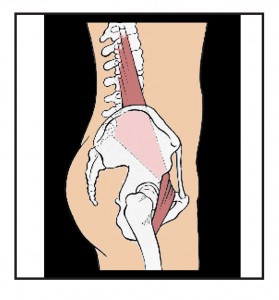Technically the body isn’t a machine of individual parts.
Nothing really works in isolation no matter how many times I implore students to engage a singular muscle.
But machine imagery can be very useful when talking about how the body works so here goes.
Within the body we find a series of arches, hinges and pulleys.
The psoas, my favorite muscle, fits in the mechanical model acting as a pulley as it curves over the front rim of the pelvis on the way to the femur.
The hip bone is the pulley and the psoas is the rope. Its alignment determines whether or not it can be employed this way successfully.
The power of its psoas major is based on its placement. In and of itself the psoas will not live where it should.
There are muscles that, when properly toned, allow the psoas to be perfectly positioned. When in this position the psoas provides powerful support for the spine all the way up to the head.
The key again is its proper placement. In physics, pulleys are pretty simple systems designed to support movement and change of direction.
When the psoas major is in the proper position at the back of the inner thigh the bones of the lower back are pulled slightly forward.
In response to this (reciprocal inhibition) the muscles of the spine (erctor spinea) lengthen up. The ability of the psoas’ downward pull to assist in the upward lift of these spinal muscles might not be strong enough without the assist from the pulley action of the psoas major and hip bone..
It is important to note that the psoas major attaches on the back half of the inner thigh.
If you are standing with your feet parallel, not too far apart, and your thighs back and under the pelvis you should have the sense of the psoas connecting to the inner thigh which will be in the back half of the body.
Turn the feet out, tuck the pelvis under moving the thighs forward and feel where the connection of the psoas is. It moves to the front plane of the body. When this happens there is no longer any tension created by the pull of psoas over the rim of the pelvis.
If the thighs move back you get the pulley and if the thigh move forward you lose the pulley.
As a simple test see if you can feel the difference in the spine with the butt tucked under, thighs forward, and the feet splayed out versus tilting the pelvis slightly forward and turning the feet in with the thighs moving back under the hips.
There should be two very different feelings as a result. Try to tune in to which is more supportive.

